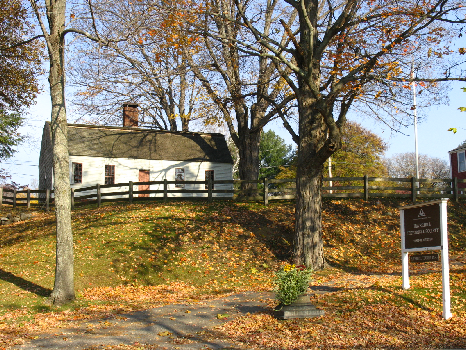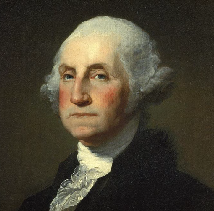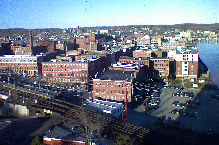
Over the last four centuries Haverhill
MA has changed out of all recognition. If the first settlers could see
it today they would be amazed at the way it has grown and prospered.
Today Haverhill MA has 60,000 residents
and three airports. The early settlers would be proud of the way the quiet
farming community they founded has grown into a modern and vibrant city.

George Washington visited Haverhill
on November 4th,
1789, as part of his ‘triumphal tour’ of New England. His impression of
the town was: “The pleasantest village I have passed through….it has commercial
advantages and beauty of location”. After his departure, the townspeople
named their main meeting square in his honour.
Haverhill Massachusetts USA.....
The early years cont. A Life Feature by Ian Hornsey


A contemporary account relates:
“Haverhill was sold by two sachems [chiefs], Passaquoi and Saggahew, and
for the princely sum of £3.10s!
In 1645 the plantation of Haverhill was
incorporated as a town, and the first church
was established there. At that time, the plantation contained about 32
landholders, and was, with the exception of open fields upon the river,
a dense and unbroken forest On 13th
February 1647 John Ward Jr. became the first minister of the new
community. He was described as: “A man of robust constitution and an excellent
divine”, and in 1652 his salary was set at £50 per annum.
In 1645, Ward’s parishioners built him
a small house – which survives until this day, and is regarded as a classic
piece of early colonial architecture. Ward continued as pastor until his
death in 1693, and was succeeded by the Rev. Benjamin Rolfe, whose much
shorter tenure came to an end when he was killed by Indians in an attack
upon the town on 29th
August, 1708. The early settlers now set about making their own laws and
one of the more colourful ones was meant to combat the “intolerable excess
and bravery of dress”.
The law stated that:
“No person whose estate did not exceed £200 was permitted to wear
any gold or silver lace or buttons, great boots, silk hoods, ribbons,
or scarfs, under penalty of 10 shillings”.
Not all of the original pioneers were evidently as pious as the Wards as can be demonstrated from the case of Tristram Coffin and his wife. In 1645. the couple were accused of “selling beere at 3d a quarte” which was contrary to the law, which required that beer should be brewed at “four bushels of malt to the hogshead” and that it should be sold at “2d per quart”. Mrs Coffin told the court she had, in fact, put six bushels into a hogshead, and the Court duly acquitted her!
As it is now, the City of Haverhill,
was until 1999, administratively in northern Essex County with the state
of New Hampshire on the north. Haverhill covers an area of almost 36 square
miles. It gained ‘city’ status in 1870. Boston is some 30-
John Winthrop (1588-
In 1645 Winthrop became the first president of the Confederation of New
England.During the early years of settlement,
the community was largely agricultural, and with the Atlantic Ocean only
sixteen miles away, fishing soon became an important industry as well.
Proximity to the sea also encouraged shipbuilding to flourish, and these
three areas of employment provided an economic base well into the 19th
century.
During the early 19th
century, a strong cattle market, and several tanneries developed, and,
as a spin-off from this, Haverhill became
an important shoemaking centre (just as its Suffolk counterpart had been
renowned for woolens centuries before). The situation was to change when
the railway came to Haverhill in 1839, some twenty-
John Ward’s House. Photo by Steve Le Bel
George Washington
HAVERHILL & THE WARDS
The Ward family from Haverhill,
Suffolk played an important pioneering role in the development of the
colony of Massachusetts, with two generations being hugely responsible
for the spiritual well-
Nathaniel
Ward (1578-1652) was born in Haverhill,
Suffolk, where his father John (who died in 1598) was vicar. He was educated
at Emmanuel College Cambridge, where he graduated in 1599, before taking
Holy Orders in 1618. Ward was originally trained for the law, at Lincoln’s
Inn, London, and admitted as an outer barrister. After practising in England,
he accompanied some merchants to the Continent, where he travelled extensively.
At Heidelberg he met the celebrated writer
David Pareus, who persuaded him to quit the law and enter the ministry.
This he did, and in 1626-28, he became
rector of the Essex parish of Stonham Massey and one of the leading Puritan
preachers in Essex.
Inevitably, his non-
In June 1639, the deputies of the
General Court of the Massachusetts Bay Company, asked Ward to draw up
a legal code. This code was adopted by the Court in December 1641, under
the title of the ‘Massachusetts Body of Liberties’. As a reward he was
granted rights to six hundred acres of land near Pentucket.
A citation of 27th
March, 1643 reads: “A tract of land containing six hundred acres was granted
by the Colony to Mr Nathaniel Ward near Pentuckett, or as near as
conveniently maybe”.
In 1645, Ward was appointed to a committee
set up to revise the laws, and, in 1648, the ‘Body of Liberties’ was replaced
by the ‘Book of the Massachusetts General Laws and Libertyes’ for which
Nathaniel Ward was largely responsible.
Ward’s book, ‘Body of Liberties’, was
the first modern legal code in the Western world, and pointed the way
to democratic, social, and political institutions, which were to be gradually
incorporated into the legal structure of other ‘colonies’ (including Connecticut),
and other nations.
On 15th
November 1642 the "Haverhill Deed of Township" was finally signed,
and a title to the land was legally purchased from the native Indians.
John Ward (Nathanial Ward’s son) together with Robert Clements, Tristram
Coffyn, Hugh Sherratt, William White and Thomas Davis signed for the settlers.